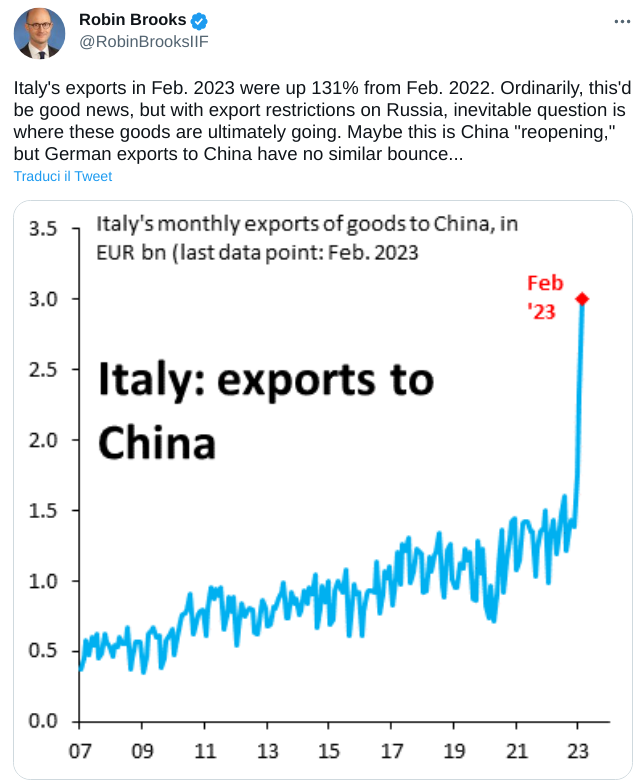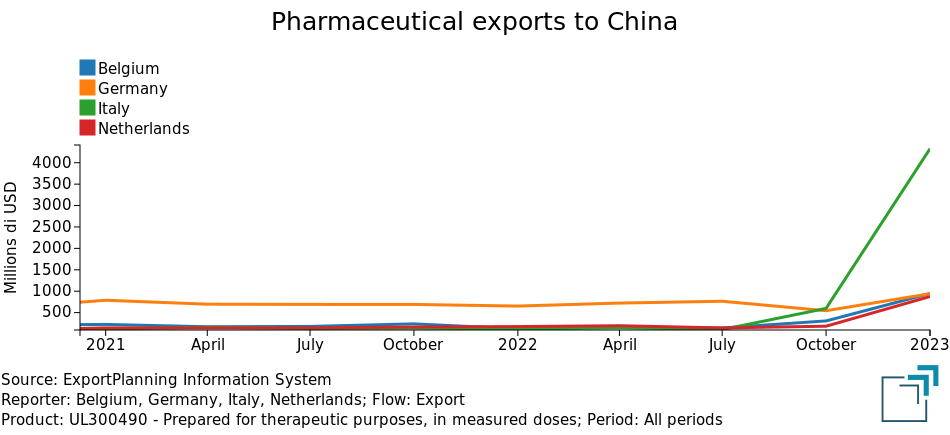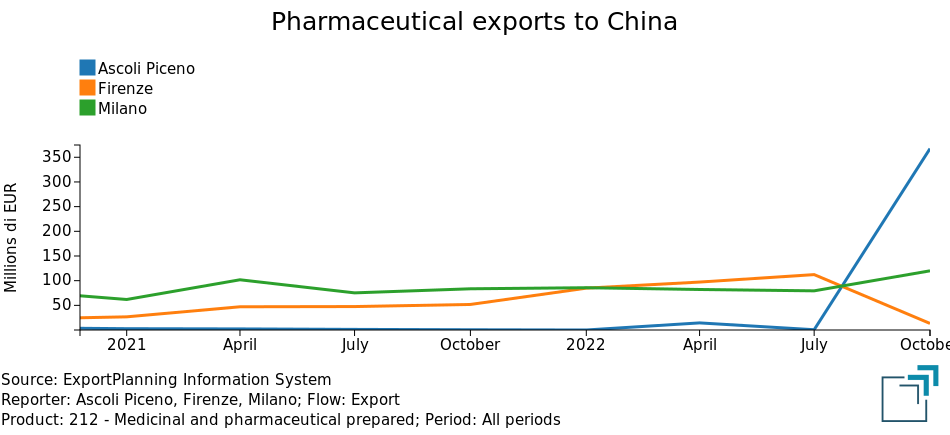Drill-down with ExportPlanning
How to start from a piece of data (or a rash tweet) and explore its determinants thanks to the ExportPedia tool
Published by Luca Surace. .
Health products Export Covid-19 Conjuncture Global economic trendsRecently, a tweet by Robin Brooks caused a great stir, in which an anomaly in the data of Italian exports to China was reported. Below is the tweet in question, published on May 4th.

|
The tweet suggests two possible explanations:
- that Italian exporters are circumventing the sanctions on Russia, triangulating their sales via China;
- hat it could be an effect of the Chinese "reopening".
The author doubts the Chinese reopening because "German exports to China have no similar bounce", suggesting that the first cause is true: Italian exporters are exporting to Russia, triangulating with China.
Robin Brooks is not a young inexperienced economist, but rather the chief economist at the Institute of International Finance, an association that includes 400 central and commercial banks, insurance companies, and investment funds from over 60 countries. Its mission is to support the financial industry in the prudent management of risks; develop strong industry practices; support regulatory, financial, and economic policies that are in the common interest of its members and promote global financial stability and sustainable economic growth.
Such an important role in a fundamental association for global financial stability would require a minimum of research before re-launching the commonplace that Italians do not respect the rules.
An investigation that could have been done in just a few minutes, using ExportPlanning.
Drill-down with ExportPlanning
The first step was to verify which industries experienced significant growth in Italian exports to China in the first quarter of 2023. Using the tool ExportPedia, which makes it possible to compare the evolution of trade between countries over time for various industries, sectors or products, it was not difficult to discover that the 130% trend increase in Italian exports to China mentioned by Robin Brooks is totally attributable by increase in drug exports which, in the corresponding period, grew by 4.2 billion dollars (+3.7 billion compared to the fourth quarter of 2022).
The second step was to verify if this dynamic only concerns Italy. Using the same tool, I checked that other countries also had a significant increase in drug exports to China in the first quarter of 2023, as shown in the chart below.

|
The chart clearly shows that, before the fourth quarter of 2022, only Germany had significant drug exports to China. In the fourth quarter of 2022, Italian exports were comparable to the German ones, and then multiplied by five in the first quarter of this year. The interesting element is that in the first quarter of 2023, other countries (Belgium and the Netherlands) also recorded significant increases in exports to China, albeit at rates lower than those of Italian exports.
At this point, a simple web search was enough to trace numerous articles which, in the early days of 2023, reported the news of the explosion in demand in China for a drug (UDCA) to treat liver disease, required by the population as a possible weapon against Covid. The world's largest producer of this drug is, coincidentally, in Italy.
If we want to delve even deeper, the signal of the increase in Italian exports in the fourth quarter[1] allowed us to investigate from which Italian province this phase of increased exports of drugs to China started. Once again using ExportPedia, but accessing the data of Italian exports by province, it was possible to obtain the information presented in the following chart.

|
From the data shown in the graph, it is evident that in the fourth quarter of 2022, in the face of the collapse of exports from the province of Florence, there was a strong growth in exports from the province of Ascoli Piceno. These data suggest that a pharmaceutical company with plants both in Florence and Ascoli Piceno transferred the production of orders of drugs specifically destined for the Chinese market from the Florence plant to the one in Ascoli Piceno. The company in question is the US company Pfizer, which produces Paxlovid, an antiviral drug against Covid, and which, in collaboration with the German company BioNTech, developed the RNA vaccine used worldwide to fight the pandemic.
With the halt of the zero-Covid policy, China has found itself unequipped, having a population that has generally come into little contact with the virus and which has protected itself, in recent years, with the Sinovac and Sinopharm vaccines, which have proved to be decidedly less effective in reducing the risk of contracting a serious infection, compared to messenger RNA vaccines available in Western countries and never authorized in China.
As a result of this change in Chinese policy, two effects have occurred which are affecting Italian drug exports in the Asian giant:
- on the one hand, Beijing is taking measures, buying vaccines and antivirals from abroad and, therefore, also from Italy;
- on the other hand, the resurgence of the epidemic has led the population to equip itself with the means at its disposal, to the point of following up on a study published in the journal Nature, in which the efficacy of a drug intended to treat liver disease, mainly produced in Italy, was only hypothesized.
Conclusions
World trade data is a valuable source of knowledge about economic facts affecting different countries of the world and their relationships. However, their fruitful use requires adequate tools that allow for in-depth analysis, using techniques developed in the field of business intelligence, such as drill-down. From this point of view, the ExportPedia tool available in ExportPlanning is a unique tool.[1]. Istat has not yet published the data on Italian foreign trade by province for the first quarter of 2023. The analysis by territory was therefore limited to the fourth quarter of 2022.


